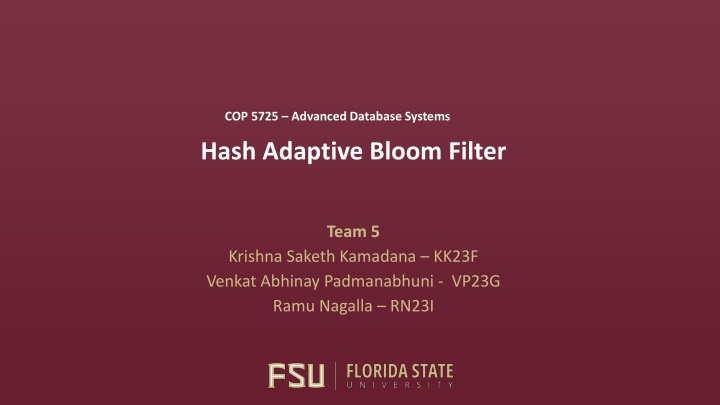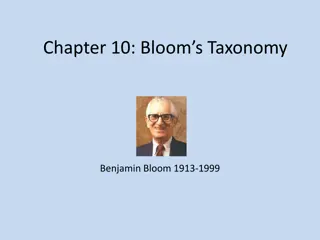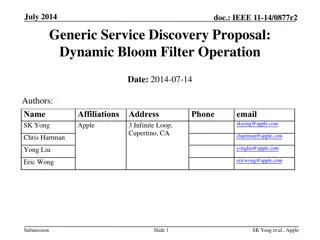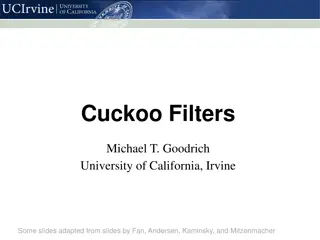
Bloom Filters: Efficient Data Membership Testing
Explore the concept of Bloom Filters, a space-efficient data structure for membership testing in large datasets. Learn how Bloom Filters work through insertion and query phases, and understand their applications in real-world systems. Discover the construction and query phases of Bloom Filters, along with their advantages and limitations.
Download Presentation

Please find below an Image/Link to download the presentation.
The content on the website is provided AS IS for your information and personal use only. It may not be sold, licensed, or shared on other websites without obtaining consent from the author. If you encounter any issues during the download, it is possible that the publisher has removed the file from their server.
You are allowed to download the files provided on this website for personal or commercial use, subject to the condition that they are used lawfully. All files are the property of their respective owners.
The content on the website is provided AS IS for your information and personal use only. It may not be sold, licensed, or shared on other websites without obtaining consent from the author.
E N D
Presentation Transcript
COP 5725 Advanced Database Systems Hash Adaptive Bloom Filter Team 5 Krishna Saketh Kamadana KK23F Venkat Abhinay Padmanabhuni - VP23G Ramu Nagalla RN23I
Membership testing problem? In many real-world systems, we often need to check if an item exists in a large dataset, without storing the entire set. This is known as the membership testing problem. Applications FLORIDA STATE UNIVERSITY 2
How Bloom Filter Works? Insertion Phase Hashes the key using K Hash Functions KEY H1 H2 Hk 0 1 0 0 1 0 0 1 0 0 FLORIDA STATE UNIVERSITY 3
How Bloom Filter Works? Query Phase Using the same k Hash functions, we get the bit positions we need to check KEY If all these bits are 1 in these bit positions, then key is probably present If any bit is 0, then definitely not present FLORIDA STATE UNIVERSITY 4
Bloom Filter We have 10-bit array, 3 hash functions, then 3 bad words h1, h2, h3 hash functions 1 2 3 4 5 6 7 8 9 10 0 0 0 0 0 0 0 0 0 0 Construction phase Keyword Hashes to Indices (h1, h2, h3) Blood 1,4,7 Violence 2,4,9 gambling 1,3,9 1 2 3 4 5 6 7 8 9 10 1 1 1 1 0 0 1 0 1 0 FLORIDA STATE UNIVERSITY 5
Bloom Filter Query phase: Positive keys: {Blood, Violence, Gambling} 1 2 3 4 5 6 7 8 9 10 1 1 1 1 0 0 1 0 1 0 Keyword Hashes to Indices (h1, h2, h3) Indices bits in bit array Positive or negative Blood 1,4,7 1,1,1 True positive Hospital 5,8,10 0,0,0 True negative Emergency 2,3,7 1,1,1 False positive Positive key: {Blood} Negative key: {Hospital, Emergency} In bloom filters, there is no chance of the false negatives (element is present, but result is negative) FLORIDA STATE UNIVERSITY 6
Bloom Filter Learned Bloom Filter Weighted Bloom Filter Standard Bloom Filter Existing work: Limitations: 1. Uniform false positive costs 2. Static Hash Functions 3. Inefficiency in Dynamic Workloads 4. High overheads in ML-Based Filters Suppose the positive key set is denoted by S, the negative key set is denoted by O, the global hash function set is H, the number of hash functions is k, and for a certain key e, the cost of e is (e). Our problem is how to build a Bloom filter so that the overall cost of false positives from O is minimized. FLORIDA STATE UNIVERSITY 7
Hash Adaptive Bloom Filter Query phase Construction phase FLORIDA STATE UNIVERSITY 8
Example Global hash set S = {h1, h2, h3, h4, h5, h6} Input : positive keys - (Blood, Violence, Gambling) negative keys - (education - 2, emergency 12). Construction phase 1 2 3 4 5 6 7 8 9 10 Bloom Filter: 10 bit array, initial H = {h0, h1, h2} 0 0 0 0 0 0 0 0 0 0 Keyword Hashes to Indices (h1, h2, h3) Blood 1,4,7 1 2 3 4 5 6 7 8 9 10 1 1 1 1 0 0 1 0 1 0 Violence 2,4,9 gambling 1,3,9 FLORIDA STATE UNIVERSITY 9
Example Collision key: emergency hashes {2,3,7} all 1, but 7 only set by blood 1 2 3 4 5 6 7 8 9 10 1 1 1 1 0 0 1 0 1 0 Adjust blood : Drop h 7, pick new h 5 Store this (blood)={h ,h ,h } (modified H) in the Hash Expressor Collision key: education hashes {4,7,9} 7 is 0, so we don t adjust anything for this. 1 2 3 4 5 6 7 8 9 10 1 1 1 1 1 0 0 0 1 0 This two phases are called Two Phase Joint Optimization FLORIDA STATE UNIVERSITY 10
Hash Adaptive Bloom Filter Query Phase positive keys - (Blood, Violence, Gambling) negative keys - (education - 2, emergency 12). (e) from HashExpresso r Round 1 bits Round 1 Result Round 2 bits Round 2 Result Original outcome Query Indices blood {1,4,7} [1,1,0] Negative {h ,h ,h } [1,1,1] Positive Positive hospital {5,8,10} [1,0,0] Negative H [1,0,0] Negative Negative emergency {2,3,7} [1,1,0] Negative H [1,1,0] Negative Negative education {4,7,9} [1,0,1] Negative H [1,0,1] Negative Negative violence {2,4,9} [1,1,1] Positive H Positive gambling {1,3,9} [1,1,1] Positive H Positive This phase follows Two-round pattern FLORIDA STATE UNIVERSITY 11
HABF technical merits: Cost-Aware Hashing: Adjusts hashes to avoid collisions with costly negatives, cutting weighted false positives by up to 40%. Two-Phase Optimization: Refines hashes (Phase I) and stores them efficiently (Phase II) using HashExpressor. Two-Round Query: Fast Round 1 with global hashes; Round 2 for adjusted keys zero false negatives, ~5% overhead. Lightweight Storage: HashExpressor adds only ~5% memory, avoiding large storage overheads. Theoretical Bounds: Guarantees on weighted false positive rate under cost skew. Empirical Wins: Outperforms other filters in accuracy, speed, and space on real datasets. Constructed a variant of HABF by reducing the construction phase time, but this has some performance limitation. Datasets: Shalla s Blacklists: a URL blacklist dataset containing 2.927 million distinct keys, of which 1,491,178 are positive (in the set) and 1,435,527 are negative (not in the set). YCSB: a synthetic key value workload of 24,074,812 keys (12,500,611 positive, 11,574,201 negative), each a 4-byte prefix plus a 64-bit integer. FLORIDA STATE UNIVERSITY 12
Results FLORIDA STATE UNIVERSITY 13
Results FLORIDA STATE UNIVERSITY 14
Thank you! Any Questions????? FLORIDA STATE UNIVERSITY 15






















